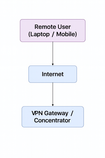Installing 3rd Party SSL Certificate on CISCO WLC
- Author Ermias Teffera
- Jul 28, 2015
- 3 min read

Why do we need SSL Certification in the first place
Well there is HTTPS Server on the WLC enabled by default for web administration & Web Policy (Web Authentication/Pass through). Provide SSL Encryption between Wireless Clients & WLC to protect web authentication.The issue begins when an end user receives a security warning When Triggering the web policy page on the WLC. A Self-Signed Certificate (SSC) is installed on the WLC by default.The solution is to Deploy a 3rd Party Certificate Signed by a public CA*.
This blog will help you install a third party SSL Certificate on cisco WLC.
WLC Requirements:
Wireless controller Code Version 5.1.151.0, or higher.
OpenSSL 0.9.8 (1.0.0 is not compatible at this time)
Up to level 2 certificates are supported on the WLC
1024 and 2048-bit certificates are currently supported
STEP 1: install and open the OpenSSL application
1: If using Gnuwin32 OpenSSL for Windows: Open via Command Line: (C:\Program Files (x86)\GnuWin32\bin0
2: Issue the following command
req -new -newkey rsa:1024 -nodes -keyout mykey.pem -out myreq.pem or
req -new -newkey rsa:2048 -nodes -keyout mykey.pem -out myreq.pem
3: provide the requested information including common name matching the DNS hostname
SLXLM.
4: once complete, two files are created under the bin directory. Mykey.pem – this is the key file which will be used once the certs arrive Myreq.pem – this is the request that will be sent to the CA
Be sure to keep both.
STEP 2: Obtaining certificate from your CA
1: login to your certificate web portal, and provide the myreq.pem file when creating the new certificate
Note: if an optional password was used when creating the request the request, be sure to provide this password to the CA when submitting.
2: your CA will notify you when your certificate is ready and provide a method to download
3: when downloading the certificate, ensure that you obtain the following:
Device Certificcate
Intermediate Certificate
Root Certificate
STEP 3:Changing the Certificate
1: Once you have all the certificate, copy and paste the content into a new file as follows
------BEGIN CERTIFICATE------ *Device cert* ------END CERTIFICATE------ ------BEGIN CERTIFICATE------ *Intermediate CA cert * ------END CERTIFICATE-------- ------BEGIN CERTIFICATE------ *Root CA cert * ------END CERTIFICATE------
2: save the file as All-certs.pem
3: move the file where OpenSSL resides
Mykey.pem
All-certs.pem
4: Open OpenSSL (via Command Line), and issue the following command
---this is converting All-certs.pem file to All-certs.p12 ---
pkcs12 -export -in All-certs.pem -inkey mykey.pem -out All-certs.p12 -clcerts -passin pass:check123 -passout pass:check12
---this is converting All-certs.p12 file to final.pem ---
pkcs12 -in All-certs.p12 -out final.pem -passin pass:check123 -passout pass:check123
5: if all successful you will have a file called “final.pem” move the file in to the tftp root directory
STEP 4: Downloading final.pem to the WLC
1: Open your TFTP Server, and verify that final.pem is within the root directory on the server
2: login to your WLC via the web GUI, and choose the following path
WebGUI -> Security -> WebAuth -> Certificate
Check the box “ Download SSL Certificate”
3: when ready click apply in the upper right.
Most likely Reboot is required .
Troubleshooting Tips:
1: I experience some issue when issuing “req -new -newkey rsa:1024 -nodes -keyout mykey.pem -out myreq.pem” command to create mykey.pem file and myreq.pem file, I did some research and find out that my windows was missing a file name “OpenSSL.CNF” if you have same problem create the file by simply copying and pasting the following commands and save it as such: if you don’t have this issue go to step 2.
https://docs.oracle.com/cd/E19509-01/820-3503/ggeyz/index.html
2, OpenSSL does not generate All-Certs.p12 or final.pem:
<>------Browse to the WebPolicy page and double –click the SSL icon in your browser to view the certificate.










Comments